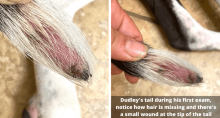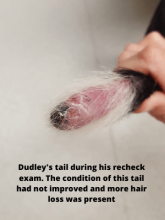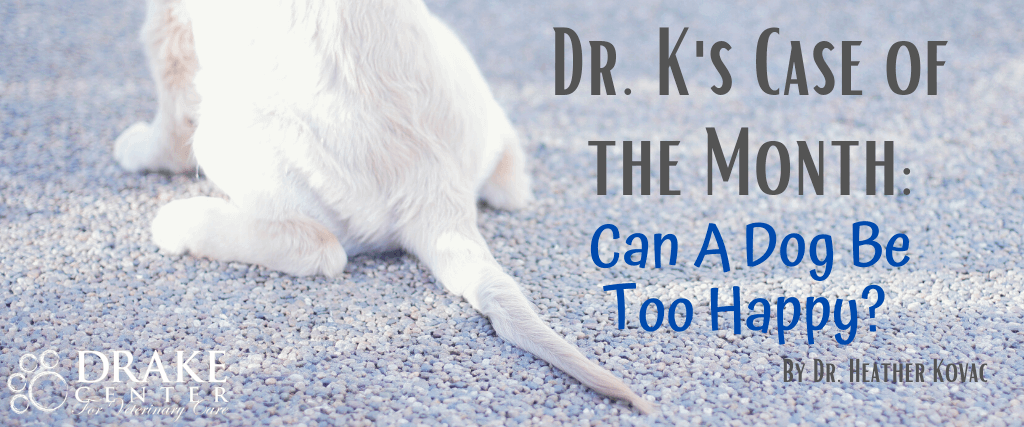By Dr. Heather Kovac
The Patient
Dudley, a 1 year old male Great Dane mix, came to see me for a wound on his tail. The owner told me that he kept hitting his tail on the walls and the sides of his crate and would cause it to bleed and it was not healing.
The Case
On examination, there was an open wound at the very tip of his tail that was ulcerated, bleeding lightly, hairless, and painful. He would not stop trying to lick the wound. This type of injury is referred to as “happy tail” because it is commonly seen in short haired dogs with long straight tails who love to wag their tails vigorously. When they get happy, they wag their tails so strongly, they can damage the skin on the tip as it hits hard surfaces such as walls or the inside of kennels. How can you tell a dog to stop wagging its tail? The answer is, you can't! Once the skin is damaged in this area it is very challenging to get it to heal properly.

The Treatment Plan
I started Dudley on an antibiotic, a pain medication, and wrapped the tip of the tail to protect it from further damage. He was also sent home with an E-collar, aka “cone of shame”, to prevent him from licking the wound and further damaging the skin. Keeping a bandage on the tail is no small feat. As you can imagine, the force of the wagging tends to dislodge the bandage. We have to get creative with the technique of bandaging the tail and it needs to be changed frequently. I rechecked Dudley about 2 weeks later. Despite all our best efforts, Dudley’s tail wound had not improved. It was nearly impossible to keep the bandage on and he continued to want to lick at it. We decided it was in Dudley’s best interest to surgically remove a portion of the end of his tail. This may sound drastic, but tail amputation is the cure for this unfortunately problem. With the tail shorter, it is less likely to hit the walls when wagged. By removing the diseased portion of the tail, the new end will heal nicely.

Dudley was taken to surgery to have this tail amputated. The surgery involves disarticulating the tail between two vertebral/back bones [yes, dogs have back bones all the way down to the tip!] and closing the skin over the end. You may be wondering what the difference is between tail docking and tail amputation. Tail docking is done as a very young puppy [about 3-4 days old] in certain breeds such as Rottweilers, Cocker Spaniels, Weimaraners, and Jack Russell terriers due to breed standards. Docking involves cutting the tail short while the bones are still forming and is a very simple quick procedure. Tail amputation is a general anesthetic procedure in older dogs and involves many layers of sutures to ligate large blood vessels and ensure proper closure of the soft tissues. Many puppies who have their tails docked also have their dewclaws [thumbs] removed at the same time.
The Outcome
Dudley recovered nicely from his procedure and has not had any complications or recurrence of his “happy” problem. If you need to schedule your pet's next appointment, please contact us here.
The Drake Center for Veterinary Care is an AAHA-accredited animal hospital located in Encinitas, CA. The Drake Center loves being a source of information for all pet owners across the country however if you have any questions regarding pet care and do not live in Encinitas, CA or surrounding cities, we encourage you to contact your local veterinarian.

